Nitric oxide orchestrates metabolic rewiring in M1 macrophages by targeting aconitase 2 and pyruvate dehydrogenase
- PMID: 32019928
- PMCID: PMC7000728
- DOI: 10.1038/s41467-020-14433-7
Nitric oxide orchestrates metabolic rewiring in M1 macrophages by targeting aconitase 2 and pyruvate dehydrogenase
Abstract
Profound metabolic changes are characteristic of macrophages during classical activation and have been implicated in this phenotype. Here we demonstrate that nitric oxide (NO) produced by murine macrophages is responsible for TCA cycle alterations and citrate accumulation associated with polarization. 13C tracing and mitochondrial respiration experiments map NO-mediated suppression of metabolism to mitochondrial aconitase (ACO2). Moreover, we find that inflammatory macrophages reroute pyruvate away from pyruvate dehydrogenase (PDH) in an NO-dependent and hypoxia-inducible factor 1α (Hif1α)-independent manner, thereby promoting glutamine-based anaplerosis. Ultimately, NO accumulation leads to suppression and loss of mitochondrial electron transport chain (ETC) complexes. Our data reveal that macrophages metabolic rewiring, in vitro and in vivo, is dependent on NO targeting specific pathways, resulting in reduced production of inflammatory mediators. Our findings require modification to current models of macrophage biology and demonstrate that reprogramming of metabolism should be considered a result rather than a mediator of inflammatory polarization.
Conflict of interest statement
The authors declare no competing interests.
Figures
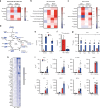

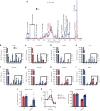
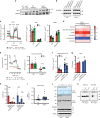

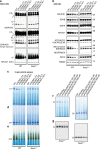
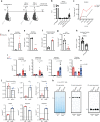

Similar articles
-
Pyruvate Dehydrogenase Kinase Is a Metabolic Checkpoint for Polarization of Macrophages to the M1 Phenotype.Front Immunol. 2019 May 7;10:944. doi: 10.3389/fimmu.2019.00944. eCollection 2019. Front Immunol. 2019. PMID: 31134063 Free PMC article.
-
Pro-inflammatory Macrophages Sustain Pyruvate Oxidation through Pyruvate Dehydrogenase for the Synthesis of Itaconate and to Enable Cytokine Expression.J Biol Chem. 2016 Feb 19;291(8):3932-46. doi: 10.1074/jbc.M115.676817. Epub 2015 Dec 17. J Biol Chem. 2016. PMID: 26679997 Free PMC article.
-
Nitric Oxide Modulates Metabolic Remodeling in Inflammatory Macrophages through TCA Cycle Regulation and Itaconate Accumulation.Cell Rep. 2019 Jul 2;28(1):218-230.e7. doi: 10.1016/j.celrep.2019.06.018. Cell Rep. 2019. PMID: 31269442 Free PMC article.
-
Pyruvate dehydrogenase kinase regulates macrophage polarization in metabolic and inflammatory diseases.Front Immunol. 2023 Dec 18;14:1296687. doi: 10.3389/fimmu.2023.1296687. eCollection 2023. Front Immunol. 2023. PMID: 38193078 Free PMC article. Review.
-
The Role of Pyruvate Metabolism in Mitochondrial Quality Control and Inflammation.Mol Cells. 2023 May 31;46(5):259-267. doi: 10.14348/molcells.2023.2128. Epub 2023 Feb 9. Mol Cells. 2023. PMID: 36756776 Free PMC article. Review.
Cited by
-
An Army Marches on Its Stomach: Metabolic Intermediates as Antimicrobial Mediators in Mycobacterium tuberculosis Infection.Front Cell Infect Microbiol. 2020 Aug 25;10:446. doi: 10.3389/fcimb.2020.00446. eCollection 2020. Front Cell Infect Microbiol. 2020. PMID: 32984072 Free PMC article. Review.
-
Engineered microparticles modulate arginine metabolism to repolarize tumor-associated macrophages for refractory colorectal cancer treatment.J Transl Med. 2024 Oct 7;22(1):908. doi: 10.1186/s12967-024-05652-3. J Transl Med. 2024. PMID: 39375706 Free PMC article.
-
RNA-Seq analysis of obese Pdha1fl/flLyz2-Cre mice induced by a high-fat diet.Exp Anim. 2023 Feb 21;72(1):112-122. doi: 10.1538/expanim.22-0054. Epub 2022 Oct 25. Exp Anim. 2023. PMID: 36288929 Free PMC article.
-
Anti-Neuroinflammatory Effect of Ombuin from Rhamnus erythroxylon Pall. Leaves in LPS-Induced BV-2 Microglia by Targeting Src and Suppressing the PI3K-AKT/NF-κB Signaling Pathway.Int J Mol Sci. 2024 Aug 13;25(16):8789. doi: 10.3390/ijms25168789. Int J Mol Sci. 2024. PMID: 39201475 Free PMC article.
-
Near-Infrared Light-Triggered Nitric Oxide Nanogenerators for NO-Photothermal Synergistic Cancer Therapy.Nanomaterials (Basel). 2022 Apr 14;12(8):1348. doi: 10.3390/nano12081348. Nanomaterials (Basel). 2022. PMID: 35458056 Free PMC article.
References
Publication types
MeSH terms
Substances
Grants and funding
LinkOut - more resources
Full Text Sources
Molecular Biology Databases

